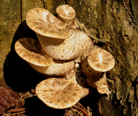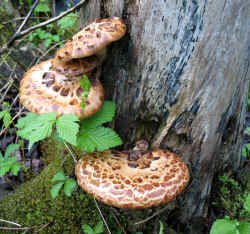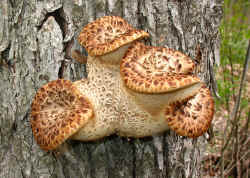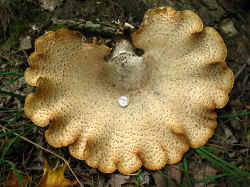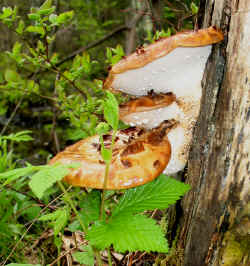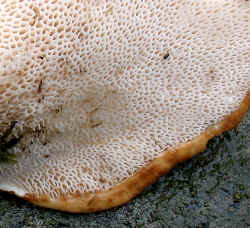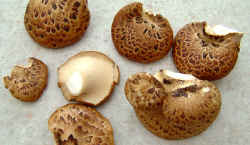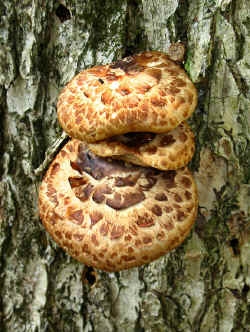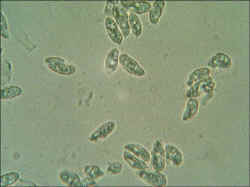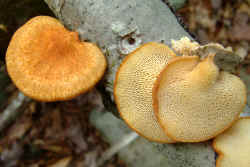|
|
A New England and Eastern Canada Edible and Medicinal Mushroom Resource |
|
Home
Chanterelle (Cantharellus cibarius) Black Trumpet (Craterellus cornucopioides, C. cenerius, C. foetidus) Small Chanterelles (Craterellus tubaeformis, C. ignicolor) Hedgehog (Hydnum repandum, H. umbilicatum) Horse and Meadow Mushroom (Agaricus arvensis, A campestris) Parasol Mushroom (Macrolepiota procera) Shaggy Mane (Coprinus comatus) (White) Matsutake (Tricholoma magnivelare) Blewit (Lepista nuda) Oyster Mushroom (Pleurotus ostreatus, P. populinus)
King Bolete (Boletus edulis) Boletus variipes and other. Two Colored Bolete (Boletus bicolor) Maitake (Grifola frondosa) Chicken of the Woods (Laetiporus sulphureus) Dryads Saddle (Polyporus squamosus)
Morels (Morchella esculenta, M. elata) Puffballs (Calvatia gigantea, Calvatia cyathiformis, others) Lobster Mushroom (Hypomyces lactifluorum) Aborted Entoloma (Entoloma abortivum)
Medicinal Mushrooms Maitake (Grifola frondosa) Reishi (Ganoderma tsugae, G. lucidum) Turkey Tail (Trametes versicolor) Chaga (Inonotus obliquus) Artist's Conk (Ganoderma applanatum)
Collecting, Photographing and
Cooking Collecting
Tips Evaluating
Flavor Dyeing Fabrics and Paper with Mushrooms
|
Dryad's Saddle When spring comes around and I can't find morels, I am always glad to find some dryad's saddle to take home. It has been much maligned as an edible of little value but I beg to differ. It is all about understanding how to pick and cook it. Cap (pileus) 2-12 in broad circular to kidney or fan shaped, thick, often overlapping on dead wood. Brown with scales that look much like feathers. Hence the names pheasant back and hawk's wing. The aroma is very distinctive smelling much like watermelon rind. Really pleasant! I have seen them described as "mealy" but that's not how they are around here. Pores (hymenophore) Actually tubes that are small at first becoming fairly large and angular running down the stem somewhat. Whitish to yellowish tan. Stem (stipe) Very short 3/4 2 in. attached to the wood. Flesh White and non bruising. Spores White spore print. This one makes one of the prettiest spore prints of any mushroom I have printed. When and where to find them (ecology) These grow on various very dead hardwoods (especially elm) mostly in May or June but occasionally later. A tree lying on the ground is your best bet. Occasionally the may be on a living tree but they seem to prefer very dead wood. Wet areas seem to produce more. These are quite common and one of only a few decent edibles you will find at this time of year. It is nice to find when morel hunting is frustrating. These will be found in the same places each year until the wood is consumed. These have been called just edible by some and poor by others. They can be quite good though. My rules are that they need to be young, the pore layer needs to be very thin (1/16 in. or less is likely to be good), and most importantly your knife needs to be able to pass through it very easily. Whatever the knife cuts easily is likely to be good. Sometimes just the outer edges are usable but nice tender ones can be found. Preparation Once you have found tender specimens, they are best cooked straightaway. Like many other wild mushrooms the aroma is ephemeral often disappearing within hours. Tempura frying will retain some of this "watermelon" character. Sautéing or pan frying is a good way too. Slice them thin and cook them hard and fast. Overcooking will create toughness. I have tried drying them. They come out as very white, crunchy chips that are pleasant to eat dry. They retained more of that unique smell than I expected. I have made a powder with them but have not tried cooking with it yet but it looks and smells good. The microwave produced something you could make shoes with. I have had pretty good luck with tough ones though. I cooked them and put them in the blender with chicken stock blending until they were the consistency of a smoothie and then made mushroom soup. Really very good and not like any other. Nothing else tastes or smells like this mushroom. It is really very good when prepared correctly. I could easily identify it by the smell with my eyes closed. Maybe it would taste "mealy" if it was stored in the refrigerator for a couple of days. Actually, since different people perceive smell and taste differently your experience could be different. Comments In the spring, this one is very common. Many you will find are quite leathery and your knife will refuse to cut it. Just let it be. Spring polypore (Polyporus arcularius) and Polyporus alveolaris look a little like it but are much smaller and very tough. Find more information here: Polyporus
squamosus at Roger's Mushrooms
Use of this site will constitute your acceptance of the disclaimer. Copyright 2011 Mushroom-Collecting.com. All rights reserved. |
